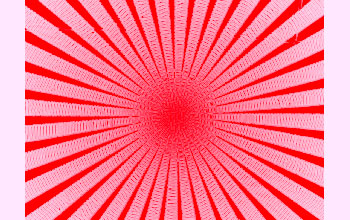Multimedia Gallery
Rising Sun
"Rising Sun," by Edwin F. Chan, polymer science and engineering.
More about this image
Take a piece of plastic wrap that you use for sandwiches and other food or push together the skin on your hand or arm. You will see the formation of ripples or wrinkles. These are basically surface instabilities that form due to the force that you are applying and, like with the plastic wrap or your skin, the direction of the wrinkles will depend on the direction that you are pushing or pulling. The mechanical properties of the plastic wrap or your skin, and the amount of pulling or pushing that you are doing, will determine the frequency of the wrinkles that are formed. Here, the wrinkles are formed by a soft polymer. The direction of the wrinkles will be directly related to the direction in which you are pushing or pulling. Near the outer edge, the wrinkles go out radically, as you would expect. But in the middle, the wrinkles are every which way, since here the force is in all directions.
This image was included in an exhibit titled "VISUAL: Ventures in Science Using Art Laboratory," shown at the National Science Foundation (NSF) headquarters in Arlington, Va., April 2006 through June 2007, as part of The Art of Science Project. The Art of Science Project was conceived and implemented by a cross-directorate committee of NSF staff. Its purpose is to bring to NSF, original works of art that visually explore the connections between artistic and scientific expression. This image is copyright and was included in the NSF Multimedia Gallery with permission. (Date of Image: 2000-2006)
More about "VISUAL: Ventures in Science Using Art Laboratory"
Just as beauty lies in the natural world, it also lies in the natural phenomena that scientists capture every day in the experiments that bring them closer to proving scientific theory. VISUAL, an outreach effort of the Materials Research Science and Engineering Center on Polymers at the University of Massachusetts-Amherst (an NSF materials research center), attempts to bring the two worlds of art and science together, not only to allow people to discover the beauty of this scientific imagery, but to inspire a wider range of interest in science through the visual arts. This effort has resulted in programs that use visual arts to promote materials science research on polymers for students in grades K to 12, as well as to the general public. These captivating images, each a direct result from research conducted on the UMass Amherst campus, have been displayed throughout the community. From exhibitions at local museums to displays at the public library and the department of motor vehicles, VISUAL reaches many sectors of the community, exposing people to materials science and educating them about the research happening in their own backyard.
The core mission of the VISUAL program is expressed in the simple maxim, "the eye is not satisfied at seeing." The beauty of the imagery draws viewers to look more closely at the image, inspiring them to want to know more. Thus begins the inquiry-based journey of learning about the origin of the image and the means by which it was captured. This link between the image and scientific understanding distinguishes VISUAL from other image-based programs. Accompanying each image is a non-technical explanation about the science underlying the image and the methods used to obtain the result, as well as a potential application of the science. By conveying the science in common, understandable terms, the scientist imparts to the viewer an appreciation of the importance of the science, in addition to the beauty of the image. [This research was supported in part by an NSF CAREER (Faculty Early Career Development Program) award, DMR 0349078.]
Credit: ©VISUAL, Materials Research Science and Engineering Center, University of Massachusetts, Amherst
Special Restrictions: This image is copyright. Permission is granted for personal use only. For further information, visit the VISUAL website Here.
Images and other media in the National Science Foundation Multimedia Gallery are available for use in print and electronic material by NSF employees, members of the media, university staff, teachers and the general public. All media in the gallery are intended for personal, educational and nonprofit/non-commercial use only.
Images credited to the National Science Foundation, a federal agency, are in the public domain. The images were created by employees of the United States Government as part of their official duties or prepared by contractors as "works for hire" for NSF. You may freely use NSF-credited images and, at your discretion, credit NSF with a "Courtesy: National Science Foundation" notation.
Additional information about general usage can be found in Conditions.
Also Available:
Download the high-resolution JPG version of the image. (1.4 MB)
Use your mouse to right-click (Mac users may need to Ctrl-click) the link above and choose the option that will save the file or target to your computer.

 All images in this series
All images in this series